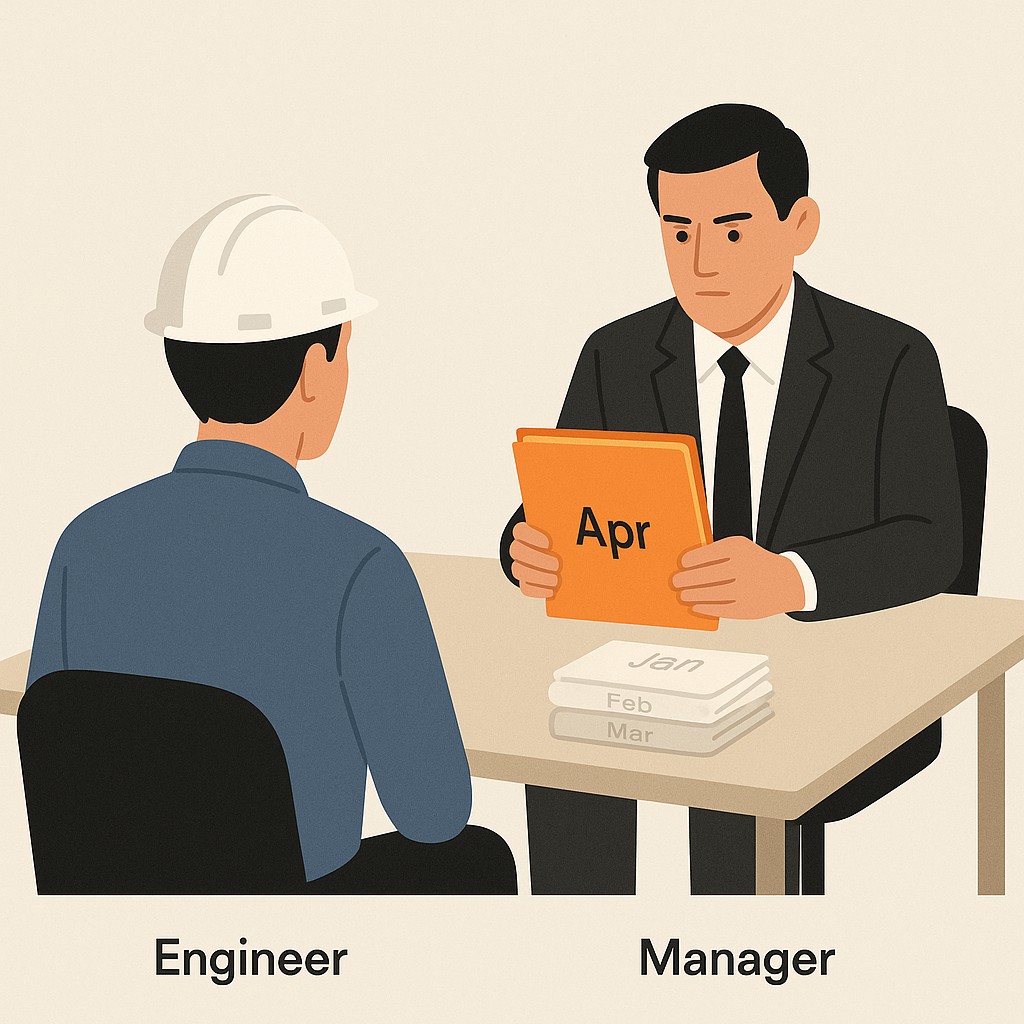How to Document Engineering Impact Without Last-Minute Scrambling
How to Document Engineering Impact Without Last-Minute Scrambling

When Your Year Gets Reduced to Last Month: Naming Recency Bias
I keep coming back to my last performance review. It was supposed to cover everything I’d done over the past year—team improvements, infrastructure wins, countless hours smoothing out invisible blockers. My manager was upbeat, congratulating me on a “strong year.” And then he only named one thing: the project from last month. It landed like a twist I should have seen coming, but honestly, it still threw me.
Have you ever walked away from feedback thinking, “Wait… Did a whole year of work just get boiled down to whatever happened last?” It’s not just you, and it’s not just me. I’ve lost count of the times I’ve watched teams push through messy, foundational work only for the story to disappear the moment something newer hits their manager’s desk.
This is recency bias in action. If you don’t learn how to document engineering impact and make your contributions visible, people default to what’s fresh in their memory. Long-term engineering work—design docs, performance refactors, those strategic changes you nudged forward—are especially exposed to being forgotten, because unless you’re loud about your wins, only the latest ones survive.
Short-term work gets all the attention. Long-term contributions fade.

But here’s the core lesson. If you want fair recognition, visibility can’t be some one-week sprint during review season. It needs to be a steady, ongoing practice, and there’s a system for making it stick.
How Snapshots Distort Impact—And Why Cadence Changes Everything
Elon Musk’s recent demand for federal workers to justify their value with five things they did last week grabbed headlines for a reason. On the surface, it feels clarifying. There’s nowhere to hide, and the focus is tightly on work you can point to right now. The initial reaction makes sense. Who wouldn’t want fresh, actionable proof of productivity? But peel that back and the second-order downside shows up quickly. This approach leaves out everything that compounds quietly—system rewrites, mentoring, research, even the “boring” platform work that makes the fun stuff possible. It frames the score as whatever happened in the last seven days, as if the rest of the year fell through a trapdoor.
I used to wait for someone to ask for a justification before I’d assemble my contributions. It felt easier not to worry until I had to, until suddenly the deadline was looming and all those scattered wins were nowhere to be found. If you’re only justifying your work when asked, you’re already behind. By then, the story your year could tell has shrunk to whatever fits in the latest snapshot.
Managers operate a bit like an LRU (Least Recently Used) cache. What’s accessed recently gets called up first, and everything else sleeps until someone digs deeper. The recency effect isn’t just a managerial quirk, it’s a side effect of how our short-term memory operates—recent work is what people reach for first in their mental cache.
That’s why infrastructure upgrades, platform refactors, and months of research quietly accrue but rarely surface unless we intentionally index those efforts by visible outcomes. Think about it: if that core service you stabilized months ago kept production humming, nobody’s remembering it until it fails or you bring it up with real numbers. Unless you turn your compounding impact into something that shows and tells, the manager’s “mental cache” will always grab the latest thing, no matter how small or trivial. That’s not laziness, it’s just how memory works under pressure. If visibility isn’t built to last, even your biggest wins fade into the background.
Earlier this year, I lost track of several upgrades we did to infrastructure because I was juggling two emergencies—a flaky API, and for some reason, a broken coffee grinder in the kitchen. I caught myself spending more time trying to fix the grinder than documenting any of the migrations. Pike’s Law in action, maybe. It makes me wonder how many solid wins have slipped through the cracks just because our attention gets hijacked by the stuff in front of us.
But the solution isn’t louder status updates. The real antidote is sustained, outcome-focused visibility that compounds across the entire year. Because checking in consistently doesn’t just keep your story alive. It makes your value harder to overlook. Workers who check in with managers weekly are five times less likely to be disengaged than those who never do, which means showing your work, steadily, is the kind of rhythm that builds recognition and impact on your terms.
Framing Outcomes and Building a Rhythm for Lasting Visibility
Let’s make this clear. “I completed three new features” is just a task on a checklist. That’s forgettable. But “I launched three features that reduced customer onboarding time by 40%” is the kind of outcome that demonstrates engineering impact. Anchor your updates to outcomes. Managers will actually remember what you did when they can picture the change it made.
Six months ago I thought my weekly notes were just for me—a scratchpad for experiments that failed, lines of code I regretted. Only later did I realize those fragments formed the outline of bigger changes. If I hadn’t kept them, I’d be stuck re-constructing history from calendar invites or Slack threads.
Here’s how you make this visible without burning out. Start small. To learn how to document engineering impact, jot daily notes about what you finished, struggled with, or saw progress on. At the end of the week, synthesize those raw moments into a short note on outcomes—what changed, who benefited, what got unlocked. Monthly, pull that into a digest: look for patterns, metrics, or real examples. You don’t need perfection. Cadence matters more than polish. 80% of employees who got meaningful feedback in the last week are fully engaged, regardless of how many days they worked onsite. Let that stick with you. Frequency builds connection.
If this sounds tedious, trust me, it’s like keeping a marathon training log or scribbling down espresso grind settings. Tiny, consistent entries create clarity over time. You capture how your pace and blend improved. So when the moment comes to judge progress, the evidence is all there.
For channels, keep it simple. Use a personal doc—literally called “Wins”—to showcase engineering outcomes. Share the important ones during 1:1s and team meetings, reinforce them during check-ins, then layer it all into formal reviews. Always lead with outcomes—what changed, how it mattered, who noticed.
You want a blueprint? Try this. Each week, record three clear outcomes, each backed by evidence—maybe a link to a PR, a dashboard chart, or a real customer quote. Each month, roll those up with a few lines about metrics and impact—did onboarding get smoother, did customer tickets drop, did a teammate unblock faster? Don’t worry about perfect grammar or fancy formatting. Just keep it lightweight, regular, and focused on showing real change. Over time, those little entries build a narrative that managers can’t ignore, no matter how busy things get. This rhythm is your safety net against recency bias, so when review season hits, your entire year is visible—not just last month’s headline.
Making Outcome Evidence Actually Land: Formats Managers Notice
It’s easy to dismiss visibility work as shameless self-promotion, but I see it differently and I want you to reframe it, too. When you track and share outcome evidence, you’re not just selling yourself. You’re acting as the steward of what really happened. This isn’t boasting; it’s about defending the truth of your impact so reviews match reality, not just the latest memory. I’ve struggled with the line between “sharing” and “overselling,” but let’s be honest, if you don’t curate the data, no one else will.
If you want managers to actually use what you send, package it so the substance is front and center. Lead with a clear outcome (“Reduced deploy time by 30%,” not “worked on deployments”), back it up with just enough evidence, and end each update with what’s next or what’s still blocked. Send it with a short, punchy subject line. Keep the structure consistent week to week and month to month so your updates get read, not just scrolled past.
The micro-update formula I use lands almost every time: share one outcome, two supporting facts, and one link for depth. This structure fights the default to recent wins because it delivers what’s important, not just what’s new. A manager short on time will click, skim, and actually see the bigger story—and you’re shaping how your contributions get remembered.
You already have more usable evidence than you think. For impact tracking for engineers, pull from metrics (even partial ones), logs, screenshots, customer shoutouts, and OKR progress. Tag your daily notes—highlight “impact” or “blocked”—and at week’s end, you’ll have everything baked in for a clean summary. You’re not scrambling for proof anymore; you’re just connecting the dots as you go.
How to Document Engineering Impact: A Concrete Plan for Year-Round Visibility
Spending 10–15 minutes a week to capture wins beats burning hours frantically compiling evidence right before your review. The truth is, small, regular updates help you avoid recency bias and stop it from hijacking your year—it’s how you convert panic into habit.
Here’s your starting blueprint. First, open an engineering brag document—literally create the file now, write the title at the top, and save it somewhere you’ll actually open. Second, define three to five clear outcomes you want to drive this quarter. Next, set weekly and monthly reminders (calendar, Slackbot, doesn’t matter) so you’ll nudge yourself to jot updates. Finally, weave these into your 1:1s and reviews. Don’t just stash them away; actively reference your doc when talking through achievements. That’s it. List, outcomes, reminders, integrate. You can start all of this in under an hour.
If you want to keep those outcome updates consistent, use our AI to turn your notes into weekly summaries and monthly digests fast, so your impact stays visible without the scramble.
Keep the cadence steady and you’ll change the entire review dynamic. Instead of your supervisor guessing what happened based on the latest sprint, they’ll have a mental “map” of your contributions spanning all twelve months. No more hoping they remember what you did last October; the real evidence is front and center because outcomes have been visible all along.
Visibility isn’t just about getting credit, it’s about making sure your real impact—especially the strategic, long-burn work—gets noticed and valued. Reviews shift from arbitrary snapshots to genuine recognition for all you’ve moved forward.
I still wrestle with the tension between documenting enough and over-documenting. Most weeks, I’m not sure where the line is. Maybe it’s not always possible to get this perfect—sometimes I miss a win, sometimes I overshare. I’m working on it.
Make outcome-focused evidence visible, continuously. This is how you neutralize recency bias—and make sure your long-term contributions get recognized without last-minute scrambling.
Enjoyed this post? For more insights on engineering leadership, mindful productivity, and navigating the modern workday, follow me on LinkedIn to stay inspired and join the conversation.
You can also view and comment on the original post here .
